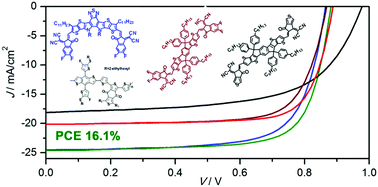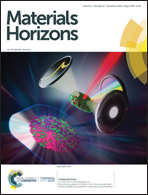The synergy of host–guest nonfullerene acceptors enables 16%-efficiency polymer solar cells with increased open-circuit voltage and fill-factor†
Abstract
Ternary blended approach, which uses a small-bandgap nonfullerene acceptor as the guest to comply with the aggregation of the host with an increased short-circuit current-density (Jsc), however, usually supplies reduced open-circuit voltage (Voc). In this study, we present a new ternary material approach with a higher-LUMO-level nonfullerene acceptor to comply with the aggregation of the host with increased Voc, which supplies a 16.1%-efficiency polymer solar cell. This ternary approach was designed on the basis of a new host binary system with PBDB-T-SF as the donor polymer and Y6, a recently reported fused-benzothiadiazole-based molecule, as the host nonfullerene acceptor. It was realized by replacing a small amount of the host with the guest ITCT, an IDTT-based, fused-ring electron acceptor. The application of this approach to another binary system, PBDB-T-SF:IT-4F, again demonstrated the same beneficial effects. The structural similarity between the guest and the host benefits the higher-LUMO-level ITCT synergized with the host, which not only maintains the homogeneous fine morphology and keeps the π–π stacking patterns of the host binary blend but also forms larger donor and acceptor phases and increases the phase crystallinity, by which the charge mobilities increased and the recombination reduced, contributing to the improved FF. The Jsc is maintained though a small amount of Y6 in the host binary blend was replaced with the guest ITCT having a wider bandgap. The results reported herein demonstrate that the use of a structurally similar nonfullerene acceptor with a higher-LUMO-level as the guest is a simple, yet effective, ternary material approach that enables increased Voc with improved device function and performance.

- This article is part of the themed collections: 2019 Materials Horizons Most Popular Articles and A selection of 2019 articles


 Please wait while we load your content...
Please wait while we load your content...